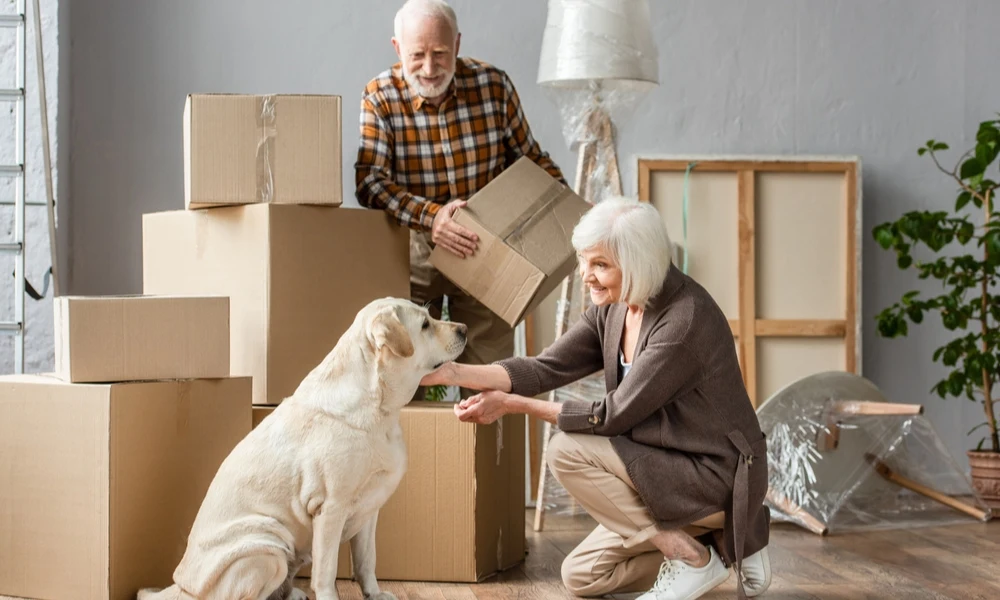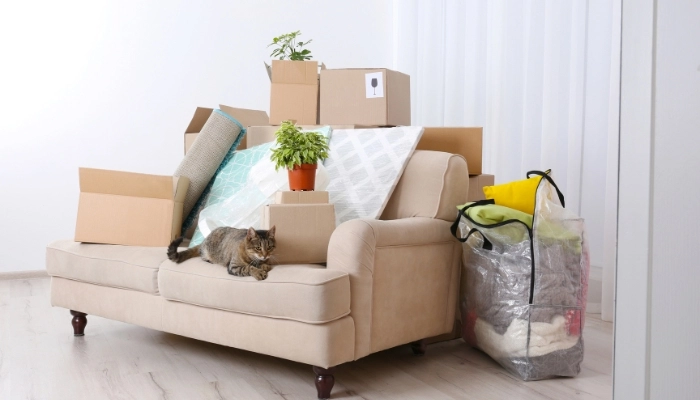Are you excited about your new home? But what about moving House with Pets? Moving to a new house with pets can be a challenging and stressful experience, not just for you but also for your beloved pets.

Pets can sense changes in their environment and may become anxious or confused during the moving process. It’s important to take the proper steps to ensure your pets are safe and comfortable during the move and quickly adjust to their new surroundings.
In this article, we will share some moving house with pets tips and the necessary steps to help make your move as smooth and stress-free as possible for you and your furry friends.
Consider the move from the perspective of your pet. More than just a house, their present home also serves as their territory. Cats are particularly sensitive and want to be in a comfortable setting.
It’s crucial to maintain the routine after the move for both dogs and cats. It will be easier for your pets to adjust to their new home if you keep the same routine for treats, grooming, and bedtime.
Preparing your pets for a move is important in ensuring that they are safe and comfortable during the transition.

Before the move, take the time to familiarize your pets with their new surroundings. You can do this by visiting the new house or apartment and allowing them to explore.
Try to keep their routine as normal as possible during the move. This includes maintaining their regular feeding and exercise schedule.
Before moving house with a dog, take your dog for a walk around your new home and neighborhood before the days of your moving home with a dog. This will help let your dog familiarize with the smells of the area and reduce their anxiety when the move takes place.
Dogs thrive on routine and consistency, so it’s better to maintain their regular walking and feeding schedule to keep them stress-free.
For a cat, it’s important to provide them with a secure and familiar hiding spot during the move. Bring their old cat tree or bed to the new home.
Make sure that your dog has current identification tags with your contact information on them. This will ensure that they can be returned to you if they become lost during the move.

Before moving, take your cat to their new home or neighborhood. This will help them become familiar with the new environment and reduce their anxiety when the move occurs.
Dogs and cats both thrive on routine and consistency, so try to maintain their normal feeding and exercise schedule as much as possible. Keep their familiar toys and blankets with you.
If you have a cat, it’s especially important to provide them with a secure and familiar hiding spot during the move. Bring their old cat tree or bed to the new home.
Ensure that your cats wear updated tags that provide your contact information. This will help you to relocate them if they are lost.
If you’re moving a long distance, consider hiring a pet-moving service to transport your pets safely to their new home.
These professionals have the experience and expertise to handle the logistics of moving pets over long distances.
By following these tips and being prepared for your pet’s needs, you can help minimize their stress and ensure that the move is as smooth as possible.
Remember that Moving can be a significant change for your pet, so be patient and give them plenty of love and attention during this transition period.
On a moving day, keep your pets in a safe and quiet room away from the hustle and bustle. This will help minimize their stress levels and reduce their risk of escaping.
If you have a dog, consider hiring a dog sitter or taking them to a dog daycare for the day. This will keep them out of the way during the move and provide them with a safe and familiar environment.
If you are travelling a long distance with your pets, make sure that you plan for their travel needs. This includes providing them with food, water, and a resting place. Bring along their favorite toys and blanket.
Once you have arrived at your new home, take the time to introduce your pets to their new surroundings. Show them around the house, including their new sleeping area.
It is also important to establish a routine as soon as possible. This will help your pets to feel more comfortable and secure in their new home.
Consider getting them a new toy or puzzle feeder to distract them in their new environment.
Moving house with your pets can be a stressful time for both you and your pets, but with the right preparation and planning, you can make the transition as smooth as possible.
By familiarizing your pets with their new surroundings and maintaining a sense of normalcy throughout the move, you can keep your pets safe and reduce their stress levels.
Remember to take it slow, be patient, and give your pet plenty of love and attention during this transition period.
Yes, moving house with a dog can make them stressed and insecure. It may take time for your dog to adjust to your new house.
Yes, your pets can get depressed after moving. The signs of their depression can include
Due to the change in environment, your cat can get sick. It’s suggested to maintain their regular meal and activities on time to reduce stress.




